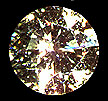DIAMONDS AND DIAMOND SIMULANTS


 This movie (68 k) shows that diamonds do not form in the kimberlite
magma but are carried up to the surface by the magma.
This movie (68 k) shows that diamonds do not form in the kimberlite
magma but are carried up to the surface by the magma.
Age: from Carbon dating ???
NO!!...... C-dating only works for very young carbon. You need to
use U-Pb or other radioactive decay schemes to date inclusions in
diamonds. Inclusions are around 100 microns in diameter (0.1 mm).
NOTE: Kimberlite magmas carry diamonds to the surface. The kimberlites
(kimberlite pipes)
are often much younger.
Under what conditions do diamonds form?
Where is C from ? May be from near-surface carbonates or from deep
mantle.
Where are diamonds found?: some brief history of diamond mining
Some further comments on the '4 C's from another source!
VALUE
The 4 "C" words:
yellow and greens,browns and greens, as well as shades of pink ( larger pink diamonds are quite rare and currently very expensive)
(2) CLARITY
: presence of blemishes or flaws, scratches, nicks, 'naturals' (the original surface of an uncut stone).
There are many systems of nomenclature.
Some terms include:
or
"first pique" inclusions readily recognizable at 10x mag., not significantly
diminishing brilliance Examples:
(3) CUT Facets are placed so as to maximize the brilliance and fire of a stone.
Remember that in the first lecture we talked about how the
proportions of a faceted gemstone are determined based on the refractive index.
A poorly cut stone is characterized by poor proportions and misplaced facets, etc. Recall the basic concepts: Review the light path in a correctly cut gem! Brilliant Cut (American cut) There are many alternative diamond cuts. For example, "Tolkowsky flower cuts", which were
introducted in the 1980s.
(4) CARAT WEIGHT
Recall: 1 carat = 0.2 g, thus 5 carats=1g
Canadian approximate price
lists
Some very useful information and
"straight talk" from Peter Mylnek
(1) TREATMENTS:
Identification: optical microscope examination:
Problem: Filling does not always resist polishing and cleaning
Look for: color zoning that follows the shape of the cut of the gem
and not original crystal features (e.g., cleavages)
Early attempts: beginning of 20th Century: diamonds exposed to radium
Modern irradiation and heat treatment: stones do not remain radioactive
Electron irradiation: PRODUCES COLOR CONCENTRATION AT THE CULET or
KEEL LINE
If irradiated from the side:
If irradiated from below
Natural blue diamonds contain the element boron, and this changes the
conductivity of the diamonds.
(2) SIMULANTS
Simulants - simulate the appearance of diamond, but ARE NEITHER MAN-MADE OR NATURAL DIAMOND!
You could go crazy staring at all the different colors of diamonds:
In order of increasing R.I., the most common simulants are:
Again:
Simulants (look alikes) differ from synthetics (synthesized by humans!) !!!!
(3) SYNTHESIS (Details on gem synthesis)
Synthetic diamonds are often yellowish in color
(supposedly these are not released for gem purposes, but used as
diamond grit for industrial purposes).
A 5 mm diamond (0.5 carat) takes over a week to grow.
Synthesis requires:
In order to recognize synthetic diamonds, look for flux inclusions (Ni,
Al or Fe).
F1 VVS1 VVS2 VVS3 VS1 VS2 SI1 SI2 I1 I2 I3
flawless imperfect
"second pique" larger inclusions, can be seen with naked eye
"third pique" many large inclusions, diminishing brilliance
VERY GOOD ... GOOD .... MEDIUM ... POOR For example, compare the size of a one point diamon
d to that of a 0.67
carat diamond
This site explains the GIA grading report used
for diamonds, including information on desirable
characteristics
Other issues: Treatment, simulants, synthetics
PROBLEM: they remained radioactive !
PROBLEM: difficult to detect treatment
From below gives color concentration around crown facets.
(YAG= yttrium aluminum garnet; GGG = gadolinium gallium garnet;
CZ= cubic zirconia.)
![]()
![]()
![]()
![]()